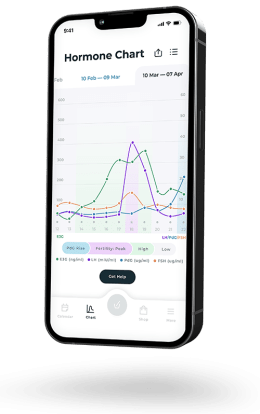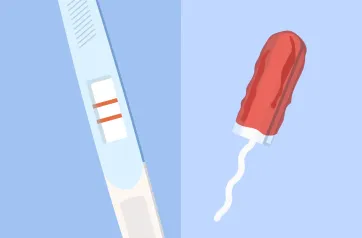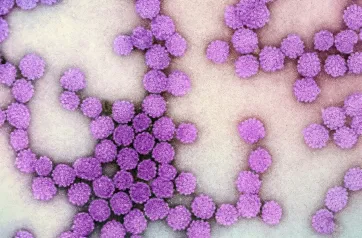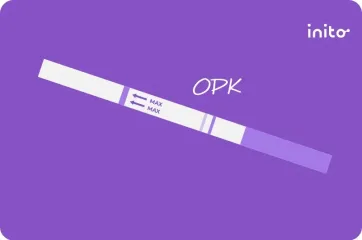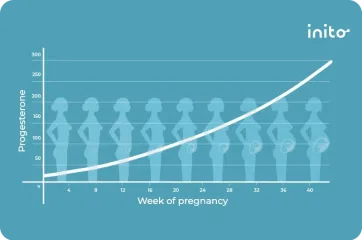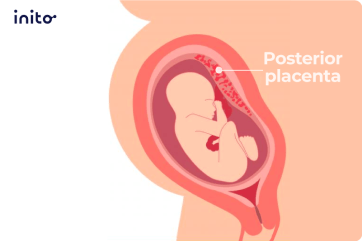Content table
One of the earliest questions most to-be-mothers have is: what does miscarriage look like? Owing to the prevalence of the phenomenon, there is always an underlying anxiety of pregnancy loss that women experience.
This fear is more persistent if you are in the early stages of your pregnancy or are pregnant for the first time.
Since pregnancy symptoms overlap with your menstrual symptoms in the initial term, differentiating between them may be a task.
Any kind of vaginal spotting or bleeding during early pregnancy can make you wonder if it’s a miscarriage or your period.
So, if you’re trying to conceive or you’re pregnant, it’s important to understand what a miscarriage is.
Read on as we explain what a miscarriage looks like including early signs of miscarriage. We’ll also cover the difference between a miscarriage and your period, myths about miscarriage, and causes of miscarriage.
What is a miscarriage?
Miscarriage is defined as the spontaneous loss of a pregnancy before the 20th week.
It is sometimes also called a “spontaneous abortion” This loss of pregnancy is not a result of what you did or didn’t do during your pregnancy.
The term “miscarriage” might suggest that the carrying of the pregnancy went wrong. But this is rarely true. Most miscarriages occur because of developmental issues in the fetus.
While it is easy for the mother to feel responsible for the loss of her baby, know that it is not your fault.
Surround yourself with a support system during this difficult time, if you are going through it, so you don’t have to bear the grief alone.
About 1 in 4 women experience a miscarriage. Most of these miscarriages occur when the woman doesn’t even know that she’s pregnant.
So the crucial question is: How do you know if you are having a miscarriage?
Let’s look at some signs of miscarriage.
What are the signs of a miscarriage?
Though most signs of miscarriage look quite similar to that of a period, they may help you identify an onset of miscarriage in later weeks of pregnancy.
If you experience any of these signs you should reach out to your healthcare provider for guidance. Watch out for:
- Light to heavy bleeding
- Severe cramping
- Fatigue and weakness along with fever
- Bloody or pink cervical mucus
- Pain resembling contractions
Now that we have a feeler on what the main signs of miscarriage are, let’s streamline how different it is to a period.
Difference between miscarriage and period
It is difficult to differentiate between early pregnancy loss and your period. When you have an early pregnancy loss, you will most likely experience the same symptoms like a period:
- Abdominal pain
- Bleeding through the vagina
- Passing blood clots or tissue
While the symptoms are similar, you know your body and your regular period pattern. You may experience stronger symptoms than your regular period cycle.
Below are a few signs that might help you identify the difference:
- Color of Bleeding: Bleeding during a miscarriage may vary from brown to dark red or pink in color. A very early miscarriage might just appear like a heavy period. Sometimes, the bleeding might completely stop before starting again.
- Lower Abdominal Cramping: While cramps are common during your periods, the ones associated with miscarriage are strong muscle contractions with pain in the lower back and pelvis.
- Passing Pink Cervical Fluid: This usually doesn’t happen during a period.
- Passing Blood Clots or Pregnancy Tissue: Miscarriage clots or tissue may be grayish or white in color, unlike regular period clots that are reddish in color.
- Sudden Loss of Pregnancy Symptoms: Pregnancy symptoms like breast tenderness and nausea might disappear post a miscarriage.
What does a chemical pregnancy or very early stage miscarriage look like?
A chemical pregnancy is a very early stage miscarriage which typically happens in the first five weeks of pregnancy.
The embryo forms and may implant into the uterine wall but does not develop. As this happens in such an early stage of pregnancy, you may not even realize you had a miscarriage.
It may look like your normal periods with abdominal pain and cramping. You may pass blood clots or tissue.
What does a 6 week miscarriage look like?
Most women don’t report anything too significant when they have a miscarriage at around 6 weeks.
You may see clots with a small fluid-filled sac. This sac may carry the placenta and the embryo, which is about the size of a lentil.
You might also see something that looks like an umbilical cord. The color may vary from dark brown to dark red or sometimes grayish.
What does an 8 week miscarriage look like?
The tissue you pass may appear dark red and shiny – some women say it looks like a liver. You might find a sac with an embryo inside, about the size of a small bean.
On a closer look, you might be able to see where the arms, legs, and eyes were forming.
What does a 10 week miscarriage look like?
The clots that are passed are dark red and look like Jell-O. You will see that they have something that has a resemblance to a membrane inside.
This is part of the placenta. The sac will be inside a clot. At this time, the baby might be difficult to see but will be developed fully.
What does a miscarriage look like at the beginning of the second trimester (around 12 to 16 weeks)?
With a miscarriage at this stage, you might notice fluid coming out of your vagina first, followed by bleeding and clots.
Although tiny, the fetus will be fully formed and outside the sac by now. You may notice the fetus is attached to the umbilical cord and the placenta.
What does a miscarriage look like in the second trimester (16 to 20 weeks)?
This is called a ‘late miscarriage’. You might pass large shiny red clots that look like liver, as well as other tissues that look and feel like membranes.
It might be very painful and feel like labor. You will need medical attention at the hospital. Your baby is fully formed and would be able to fit on the palm of your hand.
How long do you bleed after a miscarriage?
Depending on the stage at which you have a miscarriage, the length of bleeding will vary.
In the very early stages, it might feel like a regular period and bleeding may continue for a week.
Between 8 to 12 weeks, the bleeding will last for about 2 weeks or more and include some clots.
After that, you might still observe spotting for 1 or 2 more weeks. Your next menstrual cycle may be delayed and might be irregular.
The doctor may advice you to abstain from sexual intercourse, using tampons or douching to avoid any kind of infection.
Depending on your particular situation, your doctor will discuss with you the bleeding patterns you should expect.
If your bleeding lasts longer than expected or there are signs of infection, then an ultrasound might be done. This will determine whether all of the miscarriage tissue has passed out of your body.
You may be prescribed medication that induces contraction to clear your uterus of any residual tissue. You will experience cramping and bleeding for a day or two after taking the medication. In most cases, no hospitalization is required.
There are surgical options available to remove the excess tissue from the uterus.
- Vacuum Aspiration: This is done at your doctor’s office under local anesthesia. A thin tube that has suction is inserted into your uterus to suck the excess tissue out.
- Dilation and Curettage(D&C): This is an outpatient service which can be done in a surgical center or operating room. It may also require local or general anesthesia. The uterus is dilated and an instrument called a curette is used to scrape the uterine lining.
How soon can you safely get pregnant again following a miscarriage?
Miscarriages are an emotional journey and it’s important for you and your partner to take time and discuss your options with your health care provider.
In early miscarriage, you can ovulate within the next 2 weeks. You can try to conceive as early as your next cycle in most early miscarriage cases.
In case of late miscarriages, your body might take a little longer to heal. So it’s best to discuss your particular situation with your healthcare provider. Your doctor may recommend waiting a couple of months before trying to conceive again.
A miscarriage doesn’t mean that you’ll have another one or you can’t get pregnant again.
Most women who experience a miscarriage go on to have a successful pregnancy. If you have experienced more than 1 miscarriage, your doctor might suggest special tests.
Studies suggest that even after going to through multiple miscarriages, you still have a high chance of a successful pregnancy.
After a miscarriage, you might be wondering what went wrong. You may be asking yourself, “What did I do or didn’t do that led to my miscarriage?”
Like we iterated before, it’s not your fault you had a miscarriage.
Before we understand more about reasons or causes of miscarriage let’s clear out some myths about miscarriage.
Myths about miscarriage
Most women believe that they miscarried due to something they did wrong while carrying the baby. This isn’t true.
Here are a few myths about why miscarriage happens:
- Having sex with your partner during pregnancy
- Air travel when pregnant
- Eating hot and spicy food or eating a bowl of papaya or pineapple
- Lifting heavy weights or exercise
- Emotional stress or physical activity
Breathe! There is rarely anything an individual actively does that leads to a miscarriage.
Causes of miscarriage
- Chromosomal abnormalities:
Chromosomes are thread-like structures that contain your DNA material. These strands pass the genetic information from the parents to the child.Every human has 46 chromosomes in each cell of their body. As parents, you give 23 chromosomes each from yourselves to your baby. When these chromosomes differ in their structure or number, you experience chromosomal abnormalities.
In some pregnancies, the baby gets two sets of chromosomes from the father and none from the mother. Some babies get a proper set of chromosomes from their parents along with an extra set of chromosomes from the father. When this happens, the fetus cannot grow properly in the uterus. Your body has the ability to identify abnormal growth of the fetus and get rid of it.
- Age:
Maternal age can increase the chances of chromosomal abnormalities in your unborn baby. It also plays an important role in predicting the risk of miscarriage.If you conceive between the age of 20-30 years, your risk of miscarriage before you complete 20 weeks is about 8.9%. While the same risk increases to about 74.7% in women above 40 years of age.
Also, if you have had a miscarriage in the past, your risk increases to about 20% after 1 miscarriage, 28% after 2 consecutive miscarriages, and about 43% after 3 or more miscarriages.
- Placental problems:
The placenta is the organ that connects your blood supply to the baby. If there’s a problem with the development of the placenta, it can lead to a miscarriage.The placement of the placenta in the uterus might also play a role in miscarriage. Only a sonogram can detect this problem and you may have to consult your gynecologist for the same
What you can do after a miscarriage
If you have experienced or are experiencing a miscarriage, you are not alone.There is nothing you did or didn’t do that led to a miscarriage.
Know that miscarriage is a physically as well as mentally draining experience. You may feel sad and defeated, which is normal.
Take your time to come to terms with your feelings. It would help to have a partner or other figures of support to assist you in your healing process.
There is always a next time. Don’t let the grief of miscarriage discourage you from trying for a baby again. When you feel you are ready to conceive again, give it another shot.
There are a couple of ways you can ensure a successful pregnancy:
One way is to keep track of your progesterone level which is essential for a healthy menstrual cycle and pregnancy. Check out this blog to know more about how progesterone helps prevent miscarriage.
Another way is to increase your chances of getting pregnant again. You can do this by tracking your ovulation cycle and having sex within your fertility window. Inito’s ovulation and fertility tracker kit can increase your chances of getting pregnant by 89% and help you with your journey to conception
Summary
- Miscarriage is spontaneous loss of pregnancy experienced before 20 weeks of pregnancy.
- An early stage miscarriage might look and feel like your normal period. Miscarriage after 8 weeks of pregnancy might be associated with severe cramping and bleeding. You will pass clots of blood carrying tissue and membranes. The color might range from brown to dark red to grayish.
- Miscarriages happen due to chromosomal abnormalities, age, placental or hormonal problems. There is nothing you did or didn’t do that led to a miscarriage.
- It is important to have a support system around you to heal from such an emotional loss. If you wish you can try to get pregnant again once you get a go ahead from your healthcare provider.
- Keeping track of your progesterone level and ovulation cycle can help you when you try to get pregnant again.
Was this article helpful?
- Miscarriage – StatPearls – NCBI Bookshelf
- Miscarriage – StatPearls – NCBI Bookshelf
- Period or Miscarriage: Bleeding, Clots, Timing, and Other Signs
- Biochemical Pregnancy During Assisted Conception: A Little Bit Pregnant
- Early Pregnancy Loss | ACOG
- Early Pregnancy Loss | ACOG
- Repeated Miscarriages | ACOG
- New insights into mechanisms behind miscarriage
- Maternal age and fetal loss: population based register linkage study
- Miscarriage – Causes – NHS








